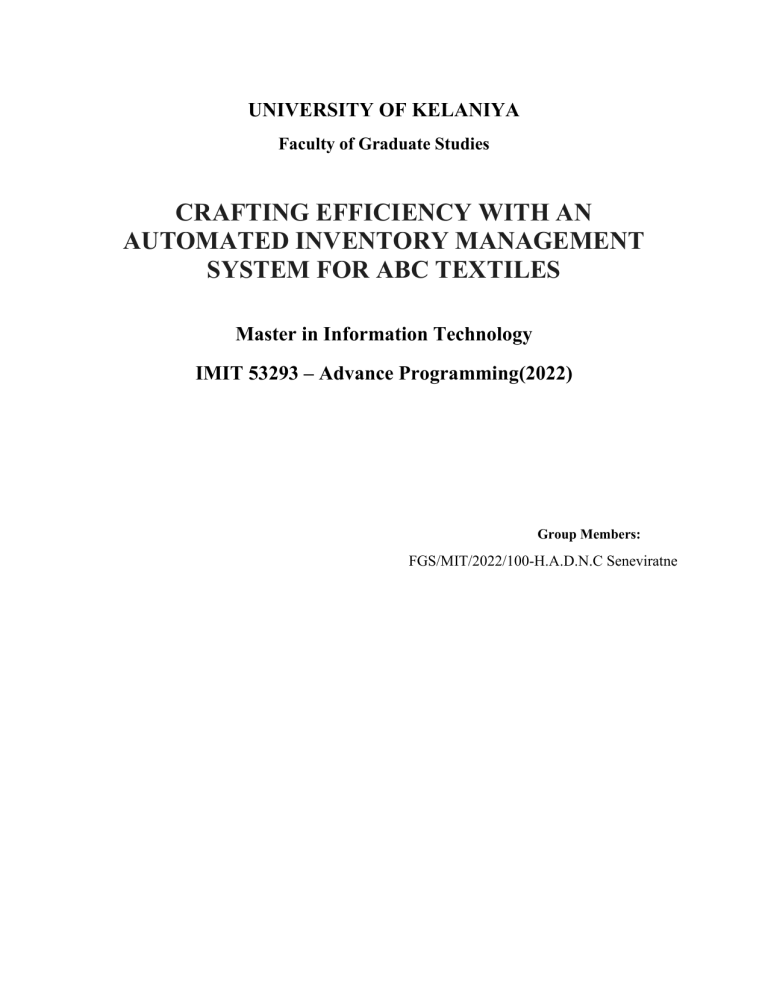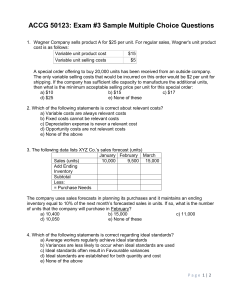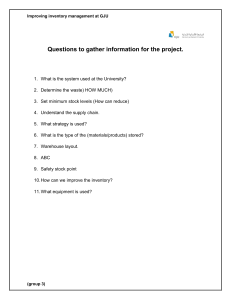Automated Inventory System for ABC Textiles - Project Proposal
advertisement

UNIVERSITY OF KELANIYA Faculty of Graduate Studies CRAFTING EFFICIENCY WITH AN AUTOMATED INVENTORY MANAGEMENT SYSTEM FOR ABC TEXTILES Master in Information Technology IMIT 53293 – Advance Programming(2022) Group Members: FGS/MIT/2022/100-H.A.D.N.C Seneviratne CRAFTING EFFICIENCY WITH AN AUTOMATED INVENTORY MANAGEMENT SYSTEM FOR ABC TEXTILES 1. Introduction: ABC Textiles, a newly established textile shop in Minuwangoda, aims to enhance its operational efficiency and accuracy through IT advancements. This project proposes the development of an Automated Inventory Management System (AIMS) using Python and MySQL, marking a significant step towards digital transformation. 2. Project Objectives: I. Streamline Inventory Control: a. Implement seamless addition, modification, and removal of product details. II. III. IV. V. VI. b. Manage supplier information effectively. c. Track stock levels in real-time. Enhanced Security and Access: a. Establish a user management system with two levels: Manager and Assistant. b. Grant Manager full system access, including user management. c. Restrict Assistant access to system operation for secure data control. Comprehensive Reporting: a. Generate on-demand, day-end, and month-end inventory reports for informed decision-making. User-Friendly Interface: a. Design an intuitive and accessible interface for effortless system navigation. Future Integration: a. Develop the system with the potential to integrate seamlessly with a future customer transaction subsystem. Flexible Payment Management: a. Accommodate diverse payment methods for suppliers: cash, bank transfer, cheque, card, and credit. 3. Technology Stack: Programming Language: Python Database Management System: MySQL 4. System Features: I. Inventory Management: a. Manage product details (name, type, size, color, quantity, cost price, selling price, etc.). b. Maintain supplier information (name, contact details, payment terms, etc.). Track stock levels and generate low-stock alerts. d. Perform physical inventory counts and reconcile discrepancies. User Management: a. Create, edit, and deactivate user accounts. b. Assign user roles (Manager/Assistant) with appropriate access levels. Reporting: a. Generate customizable reports on inventory levels, supplier transactions, sales trends, and profitability. b. Filter and export reports for detailed analysis. User Interface: c. II. III. IV. Design a user-friendly interface with intuitive features and navigation. b. Utilize visual elements like charts and graphs for data visualization. Integration: a. Develop the system with the potential to integrate with a future customer transaction subsystem for a holistic view of the business. Payment Management: a. Record various payment methods for supplier transactions. b. Track outstanding payments and generate payment reminders. c. Manage credit accounts with defined credit limits and payment schedules. a. V. VI. 5. Development Plan: a. Phase 1: System Requirement Analysis and Design b. Phase 2: System Development and Testing c. Phase 3: System Deployment and Training 6. Project Benefits: a. Increased Efficiency: Reduce manual workload and streamline inventory management processes. b. Improved Accuracy: Maintain accurate inventory data and minimize errors. c. Enhanced Decision-Making: Gain valuable insights from detailed reports. d. Enhanced Security: Ensure data integrity with user access control. e. Greater Customer Satisfaction: Improve product availability and fulfillment. f. Scalability and Future Integration: Build a foundation for future business growth. 7. Conclusion: Developing the AIMS using Python and MySQL will significantly enhance ABC Textiles' operational efficiency, accuracy, and decision-making capabilities. Its user-friendly interface, comprehensive features, and future integration potential will empower the shop to thrive in a digitally driven textile market.



